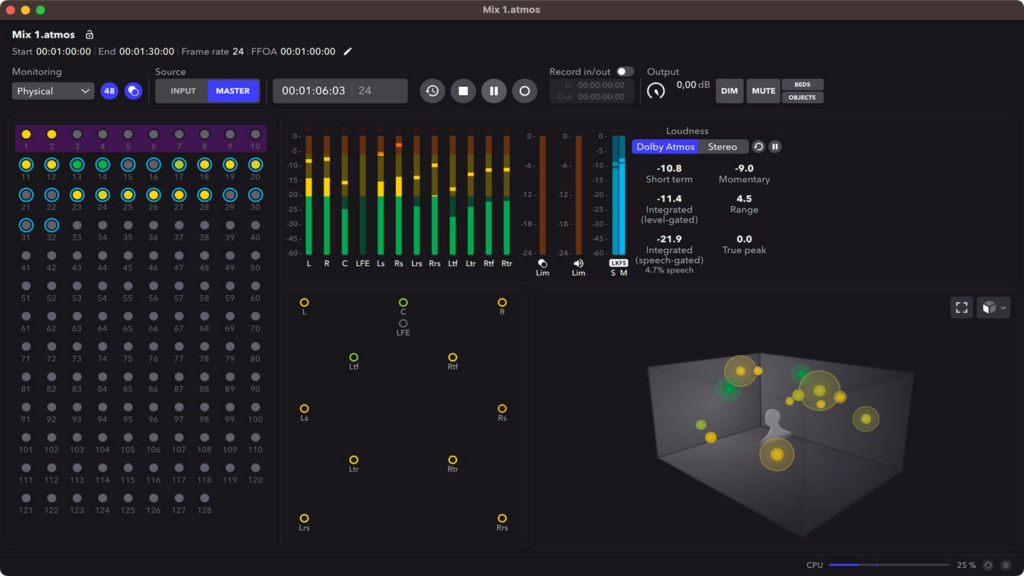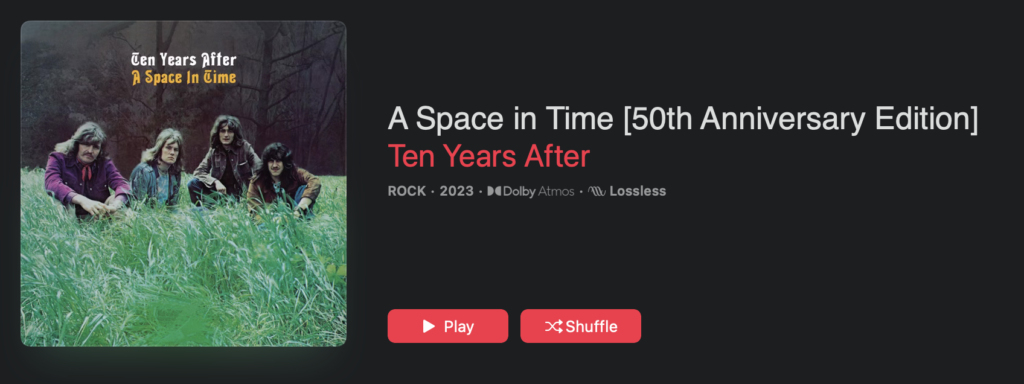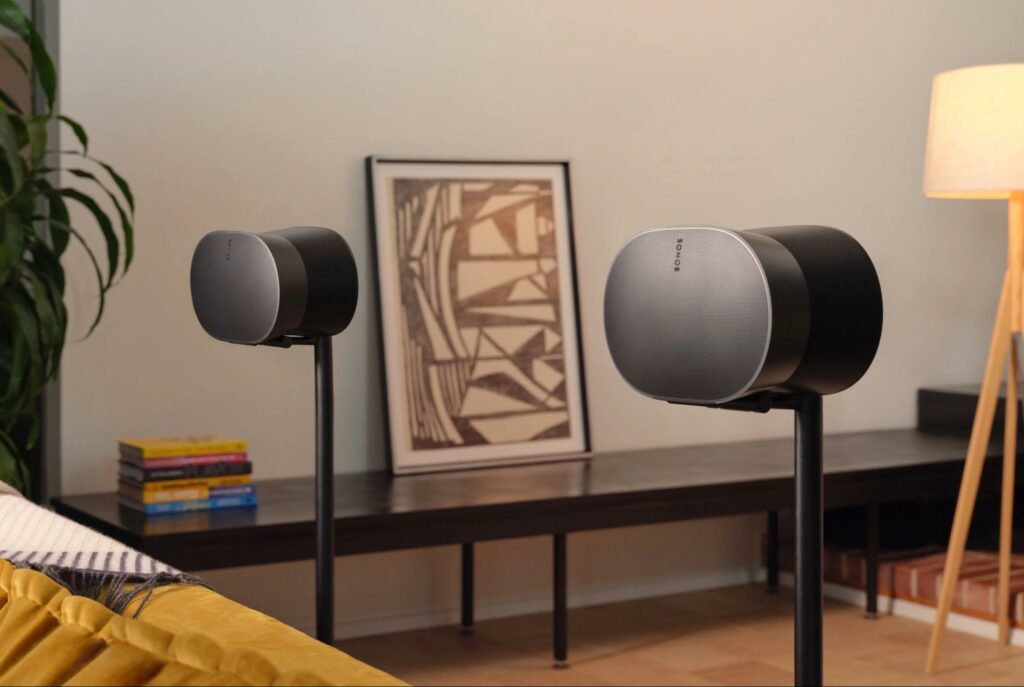Kurt Martinez is recording and immersive mix engineer based at the historic Dean Street Studios in Soho, London–home to two state-of-the-art 9.1.4 PMC Dolby Atmos Music suites.
Through his career, Martinez has worked from a number of well-known studios across London, including the world-renowned Sarm and Metropolis. He recently engineered and mixed three top-10 singles in Dolby Atmos, including the platinum-selling, BRIT-Award nominated ‘Rain’ by Aitch & AJ Tracey, ‘Padam Padam’ by Kylie Minogue and the Switch Disco & Ella Henderson collaboration ‘REACT’.
Early this month, I had the chance to chat with Kurt about his career, experience with Atmos mixing, and where he thinks the industry is headed.
In as much detail as you’d like to go into, how did your career in audio engineering start?
So I studied music tech through university, then ended up working at Apple for a year two before going back to school for my Masters. I never planned to do the Masters, but I feel it’s really done me a favor in the long run.
I eventually moved to London and found work as a runner in a post–production studio, but always had the idea I was going to work in music eventually. During my days off, I was doing mixes on the cheap or for free and sending out reels to studios. I eventually managed to start assisting in a few other studios and it’s kind of gone from there.

Who introduced you to the concept of immersive audio?
During COVID, I remember hearing rumblings about Universal looking to do these immersive mixes.
Coming out of the pandemic, I was working at Blue Box Studios in West London. I think they were the third studio in London to adopt the Dolby Atmos format? So I kind of learned the ropes of the format there, then moved over to Dean Street full time.
I remember reading a press release from Universal way back in 2019 announcing that they’d already stockpiled 200 or more songs in Dolby Atmos. It seemed hard to believe at the time, as Blu-Ray disc was the only release option then, but when immersive streaming launched with Tidal in 2020–and then Apple the following year–it all made sense.
Yeah, that was exactly my thinking.
I’d heard these odd rumblings about the labels wanting immersive mixes and wondered how that could work, because you’d need physical media to manage file sizes that big. Lo and behold, just a few years later they’ve figured out how to implement Atmos streaming and get the format to work on headphones,
I was at Dolby in Soho the other night, for the press screening of the new Billy Idol film Stateline that I’d just mastered the Atmos audio for. I forget the figure, but one of the guys at Dolby mentioned how many thousands of songs have become available in Atmos just within the last two years. It’s absolutely insane how far they’ve come.
What’s the Atmos setup at Dean Street like?
We’ve got two studios. I’m pretty sure studio one was the second to be Atmos-equipped in London, after Abbey Road and later Blue Box.
Studio one is all PMC speakers: We’ve got IB2S in the front and Wafer1’s for the heights and surrounds. In studio four, we’ve got MB3’s up front and the Ci65 series for the heights & surrounds. So it’s a smaller room overall, but similar sounding to studio one. The great thing is that you can start a project in one room and check it back in the other to see how things translate, which is rare to be able to do with Atmos.

9.1.4 adds the front wide speakers, which are pretty rare to see in consumer systems. Do you find they have an audible benefit?
We’ve kind of gone with the idea of future proofing. As far as consumer products go at the moment, I don’t think any of the soundbars go beyond 7.1.2?
Perhaps that may change as time goes on, so I’m working with a 9.1.6 object bed to ensure these Atmos mixes won’t need tweaking in a few years’ time.
That’s one of the most fascinating aspects of the Atmos format to me, that you could be mixing for more speakers than actually exist in your setup.
Exactly. When I started at Blue Box, they had a 7.1.4 setup. So I’d use objects to kind of imitate the wide speakers, if you like.
Now, working at Dean Street and having access to the PMC showroom in Islington, I’ve spent time over there seeing how these extra speakers fit into the overall equation. The clients are always happy to see the meters hitting all the speakers. [laughs]The clients are always happy to see the meters hitting all the speakers. [laughs]

If possible, explain your approach to mixing music in surround sound. Some prefer a more conservative route and use the additional speakers primarily for reverberation, while others are more experimental and place isolated instruments behind or above the listener. Are you trying to create a ‘center of the band’ or ‘in the audience’ perspective? Where do you draw the line between ‘immersive’ and ‘gimmicky’?
It definitely changes depending on the project.
At this point, I’m typically keeping drums, bass, and lead vocals upfront. If there’s a distortion or ‘crush’ track that comes with the drums, I might move that out into the room–but as a general rule of thumb, the drum stem is locked pretty much left and right. Same goes for the bass.
The drums, bass, and vocals tend to get hit with the most limiting in mastering, so it makes sense to me–particularly when you translate back for headphones–that they’re locked in place upfront too. You want to try to get that same ‘punch’ and energy as the stereo master.
Plus, some of the labels don’t like having isolated vocals in the center speaker. So I’ll keep that phantom center, but delays and reverbs can be fed out all around the room.
Overall, I find that keeping the drums, bass, and lead vocal in the front left and right really helps with the translation to headphones. I always take my mix out of the studio and try to listen in normal situations, like with EarPods or AirPods max during the commute. I’ve got a Sonos ERA 300 at home, so I’ll listen back on that too and see if anything pokes out or doesn’t feel right.

Aside from those three elements staying upfront, really anything else goes for me.
Synths are a big one for me, because they have that kind of natural movement to them. I find they work great in terms of using automation: if there’s a glitch-y effect, I like to throw that all around the room. It kind of tickles all the speakers as it goes by.
Guitars are tricky, because I grew up on bands and guitar music. There’s a few mixes I’ve heard where the guitars fly around the room, which I find really off-putting. Sometimes I’ll mix the rhythms wider and keep the leads a bit further forward, but I prefer to keep guitars static.
Tell us about remixing Ten Years After’s “A Space In Time” in Dolby Atmos. How did you come to be involved in that project?
Jazz, who runs Dean Street Studios, is Alvin Lee's daughter—so that’s kind of how it ended up on my desk.
They were planning to do a 50th anniversary reissue of that record, but the pandemic ended up pushing it back. The idea of the Atmos mix came right around the time I started heading up Atmos at Dean Street, so it fell in my lap at just the right time. It could just as easily have come out with no Atmos mix a year earlier, so I feel lucky to have been involved.
I remember the stems Chris [Kimsey] sent had all the guitars in mono and the drums in stereo. There’s a lot of panning moves that weren’t baked into the stems, so I had to listen back to the stereo and match all of those. A lot of the vocals were dry as well, which meant having to recreate the reverbs. It was a lot of fun to work and really made me think about my approach.

So Chris remixed the album in stereo from the original multi-tracks, then you created the Atmos mix using stems he sent?
It was kind of half-and-half, in terms of stems versus pure multitrack. The drums he sent were a two-track with all the effects baked in. The keys, Leslie, and some other effects were stereo too, but the guitars were definitely mono and the vocal was for the most part dry. So there was a lot of going through and trying to match those reverbs to the stereo.
I used the FabFilter Pro reverb for the vocals mainly because it has that useful graphic display, so you can kind of gauge the pre-delay and decay time visually as well as audibly.
A Space In Time was released not only via streaming, but also as a limited-edition Blu-Ray disc from SuperDeluxeEdition.com. Do you believe there’s a substantial difference in overall sound quality between the DD+/JOC lossy streaming Atmos codec and the lossless TrueHD presentation on Blu-Ray?
Yeah, it’s interesting because Ten Years After was the first time one of my Atmos mixes was released on Blu-Ray. Since then, I’ve been involved in a Duran Duran live project that was also released on disc. There’s a few more scheduled, one before Christmas and at least two more out early next year.
The interesting thing about Apple’s implementation of Atmos in particular is that they kind of ignore the binaural ‘near/mid/far’ render modes in favor of their own algorithm. So if I’m working on an audio-only project, I’ll move my ADMs from Pro Tools into Logic to check how they sound on Apple’s binaural renderer.

I picked up a pair of AirPods Max solely for the purpose of checking Atmos mixes and the results have been interesting, to say the least. I find that the heights don’t really translate, but rather the position that resolves the best is actually the side surrounds–on some mixes, you really do get the impression that specific instruments are floating outside the confines of the headphones.
Yeah. I don't think the heights are quite there yet in headphones, but we'll get there eventually.
Have you heard Michael Jackson’s Thriller in Atmos? At the very start of the title song, there’s a sound effect that sort of creeps around the back of the room. I found that particular part really impressive in headphones.
So to check the consumer immersive experience, you’re using AirPods Max and a Sonos ERA-300 speaker?
Yeah, I was using the AirPods Max pretty religiously up until the ERA-300 came out. I’ve got it set up in the living room and I’ll move around to see if anything pokes out. One thing that’s really nice about that speaker is you do get some degree of control over the side and height levels.
For the general consumer that isn’t really going out of their way to build a full-on Atmos system, I think it’s a great product. You definitely notice a difference versus regular stereo.

Going back to Ten Years After, one of the cool things about that record is that there was also a quadraphonic mix done in the early-1970s. Did you listen to the quad mix before creating the 5.1 & Atmos version?
I knew it existed, but I purposely didn't go out of my way to get hold of it. During mixing, my main reference was the new stereo mix that Chris [Kimsey] did. I wanted the Atmos mix to be an entirely new surround interpretation.
One of the most interesting aspects of the quad mix is that the drums are frequently placed entirely in the rear speakers–if you solo the rears on “I’d Love To Change The World,” you’re basically getting the isolated drum track plus Alvin Lee’s guitar. I’d read an interview that Chris gave earlier this year about the album and surprisingly enough, he mentioned that the drums on that song were actually overdubbed–which explains how they were able to get that kind of separation.
That’s crazy. I think I have a copy of the Blu-Ray around, I’ll have to check it out.
If you could mix any previous album in Atmos, what would you choose?
I knew you were going to ask this and I was planning to give a non-committal answer [laughs], but growing up I was a huge fan of Jerry Finn as a producer. He did a lot of Blink-182, early Green Day, Alkaline Trio, AFI, Sum 41, etc. I grew up on that stuff, so it would be an incredible experience for me to sit down and pick apart his stems as a fan.
One specific album that comes to mind is A Thousand Suns by Linkin Park. It’s not their most well-known or critically-acclaimed work, but it’s a really creative album with so many layers to unpack. So that’s one where I’d be happy to get really creative.

It’s interesting you mention Linkin Park, as there was an Atmos mix of their debut album Hybrid Theory (2000) on the streaming services. Like you, I have memories of listening to that stuff off an old iPod with a scroll wheel–the mixes were really compressed, but they sounded big and punchy on those tiny Apple earbuds. It was interesting to hear a more dynamic presentation of the album with the layers peeled back, but it kind of sucked out all the impact.
Yeah, I think that came out not long after Apple launched Spatial Audio. I remember listening to it and noticing all these backing vocals I’d never heard before. Some of them may actually have been mixed out of the stereo version. It definitely didn’t deliver the same punch as the stereo, and I felt that way about a lot of the stuff on Apple’s Rock playlist. Some of those early Rock singles could definitely do with a revision, now that we engineers have more experience with the format.
Can you tease any upcoming immersive projects you’re working on?
There’s Billy Idol’s State Line film, which I think is out tomorrow here and on the 15th in the States for a limited cinema run. It’ll be available to stream world-wide on Veeps and releases on Blu-ray in December.
I grew up on his music, so it was an incredible experience to be involved with that. I was pretty much left to my own devices doing the theatrical mix.
There are a few other things I can’t talk about as they haven’t been announced yet. I’ve just finished two releases for a fairly well-known band, which is literally just drums, bass, and guitars. I found it similar to Ten Years After in that the band has a dedicated fan base, so there’s a lot of pressure to get it right.
Can you say if it’s a new release or a remix of an older album?
It's two live shows, one in a smaller venue and the other in a 20,000-seater stadium. So it’s two very different listening experiences.

